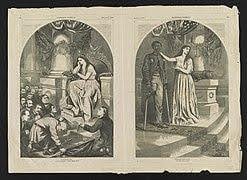Opposing Plans for Reconstruction (College Board AP® US History): Study Guide
Timeline & Summary

As the Civil War drew to a close in 1865, the nation faced the big task of reintegrating the Southern states back into the Union and addressing the status of newly freed African Americans.
President Lincoln wanted the unification process to take place quickly and with as little animosity as possible. He proposed the Ten Percent Plan. However, Lincoln’s assassination altered the course of Reconstruction. His successor, President Johnson, initially continued with a similar approach but faced opposition from Radical Republicans who wanted a more transformative process. They believed the Southern states should be forced to change their social and political systems, particularly regarding the rights of African Americans. The South was burdened with a Reconstruction that neither healed the nation nor gave relief to those emancipated by the war.
Ten Percent Plan & Reconstruction Amendments
Ten-Percent Plan
The Ten-Percent Plan was proposed by President Abraham Lincoln
It was Lincoln’s plan for Reconstruction: reuniting the states
Southern states would be readmitted once ten per cent of the voters in the 1860 election pledged allegiance to the Union
States were required to abolish slavery
States were required to ratify the 13th Amendment
The plan allowed states to quickly re-establish state governments
The purpose of the plan was to:
minimize humiliation for the south
make reunification a quick process
encourage leniency to heal divisions and prevent prolonged animosity between North and South
The assassination of Lincoln ended the implementation of the plan
He was shot on April 15th, 1854, at Ford’s Theater in Washington, DC by John Wilkes Booth
Vice President Andrew Johnson succeeded Lincoln and continued to support Lincoln’s plan, but faced opposition
Opposition to the Ten-Percent Plan
Radical Republicans and abolitionists did not support the Ten-Percent Plan
Some saw it as too lenient
They believed it did not protect the rights of newly freed African Americans
They wanted stricter terms for Southern readmission and stronger enforcement of civil rights
There was opposition to Andrew Johnson’s presidency as he supported the Ten-Percent Plan
Johnson was from North Carolina and his lenient policies were not supported by the Radical Republicans
Johnson attempted to remove Secretary of War, Edwin Stanton
Congress charged Johnson with violating the Tenure of Office Act
This led to his impeachment
The Senate failed to remove him from office
President Johnson was the first president to be impeached
Black Codes
The Black Codes were a series of laws passed by Southern state governments to limit and restrict the rights of newly freed African Americans
They reinforced a deep-rooted belief in white supremacy
They restricted the rights of African Americans so that they could not:
own property
serve on juries
access legal protection
African Americans were forced to work for low wages
Radical Republicans and Congressional Reconstruction
Radical Republicans wanted:
to severely punish the South for rebellion
to establish equality and civil rights for African Americans
reconstruction to be led by Congress, not the president
Key legislative actions
The Civil Rights Act of 1866
Ensured equal protection under the law for African Americans
The Act was vetoed by President Johnson but the veto was overridden with two-thirds of the vote by Congress
Reconstruction Acts: a series of four laws that defined reconstruction of the South
The Reconstruction Act of 1867 divided the South into five military districts governed by military troops
Required states to draft new constitutions
Required states to ratify the 14th Amendment (which granted citizenship to all individuals born or naturalized, including former enslaved persons)
Tennessee was exempt from the military districts, as they already met the conditions
All acts were vetoed by President Johnson but overridden with a two-thirds vote by Congress
Reconstruction Amendments:
13th Amendment (1865): abolished slavery
14th Amendment (1868): granted citizenship to all individuals born or naturalized, including former enslaved persons
15th Amendment (1870): guaranteed voting rights regardless of race, color or previous condition of servitude

Worked Example

Which of the following groups would be most likely to support the perspective of the cartoon?
A. Southern politicians
B. Radical Republicans
C. Northern opponents of the war
D. Veterans of the Confederate Army
Answer:
B Radical Republicans
Rationale: Radical Republicans were located primarily in the North. They wanted to extend equality and civil rights to African Americans but were wary of Southerners seeking pardons after the Civil War.

Unlock more, it's free!
Did this page help you?